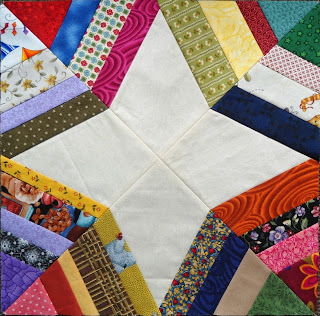WIP #2: Spider web quilt
Done some more research on the Spider web block and different ways of construction. In order for this to be a simple 'on the side' project, it has to be something where there is a minimum amount of calculations, measuring or concentration...all I want to do is use up my alarming amount of scraps.
Well, I already used the first method which involves sewing the strings on to a muslin foundation. That works fine, but made the block a bit heavy for my liking.
Another way would be to use paper as a foundation. If you want to read up on that method, you could head over to
Bonnie Hunter's website for instructions. Another great site was
Quilting Bee Blocks as it provided instructions as well as links to the various ways of constructing the block.
Well, here is my way, a bit of a combination of methods. I am using very thin interfacing as the base to work from. I like working with interfacing as it is lightweight but strong enough to act as a foundation. I leave the interfacing in the block upon completion; again, this is for convenience, as I do not want to sit and remove paper foundation. I cut a square of interfacing exactly 9 3/8" and then cut it on the diagonal for a 12" block (finished size).
Next, I made myself a template. Now this was the only time I put a lot of concentration into getting it exactly right. This template is for a finished 12" block. Head for the links above if you want to see how you can make your own template.
Align the template with the interfacing and draw two lines for the kite shape. The template includes the seam allowance.
Line up a piece of your chosen kite shape fabric RS up exactly with the line and place the next strip WS up on top of it and sew a 1/4"seam. Flip over and finger press or use a iron on low heat to set the seam (you don't want hot, as it will distort the interfacing behind it).
Next, turn your triangle over so that you are looking at the interfacing and fold over the interfacing on the drawn line on the other side of your kite shape. Align your ruler on the fold and draw a line on the fabric of your kite shape.


Cut along this line and flip the piece over again, and align your next strip of fabric to the cut kite shape.
Now here is the beauty...if you did draw (and cut) your line a bit off where it actually should have been when drawing alongside the folded over interfacing, you will see it, as your kite shape is also drawn onto the interfacing (using the template) and the interfacing is see through, so you can see it from both sides and hence can make minor adjustments (i.e. line up your strip with the line drawn on the interfacing).
(Alternatively, at this point, you could have treated this as a foundation and just stitched 1/4"off the drawn line on the back of the piece, i.e. sewing on the interfacing).
Sew in place using a 1/4"seam allowance, flip over, press and then continue to attach strips to either side of the centre kite shape.
This is what you will end up with
Now all that is left is to trim off all the excess fabric to create the triangle, using the interfacing as your guide.
Iron the seam allowances open when assembling the block (I use a mini iron to open them up and then press the block from the RS)

I achieved excellent accuracy with this method, my points match absolutely beautifully and I was able to streamline the process without having to use paper, cut out the kite shape or measure each piece individually. Added bonus, my blocks are very stable due to the interfacing being left in place, however not as heavy as when I used the Muslin as a foundation.
With that sorted out, I am looking forward to just continuing with those blocks over the rest of the year until I have enough for a bed size quilt.
Karin









































